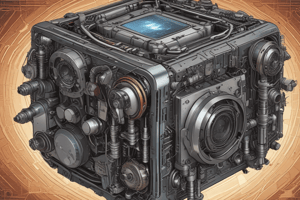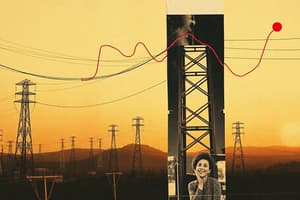Podcast
Questions and Answers
What is the gate recovery time denoted as in SCR dynamics?
What is the gate recovery time denoted as in SCR dynamics?
- Turn ON time
- Circuit turn OFF time tc
- Holding time
- Gate recovery time tgr (correct)
What is the typical range of turn OFF time for an individual SCR?
What is the typical range of turn OFF time for an individual SCR?
- 10 to 100 microseconds (correct)
- 50 to 60 microseconds
- 200 to 300 microseconds
- 1 to 5 microseconds
Which type of SCR is characterized by a turn OFF time between 50 to 100 microseconds?
Which type of SCR is characterized by a turn OFF time between 50 to 100 microseconds?
- Inverter grade SCR
- Converter grade SCR (correct)
- Fast recovery SCR
- Transformer grade SCR
What happens if the circuit turn OFF time tc is not greater than the turn OFF time tq?
What happens if the circuit turn OFF time tc is not greater than the turn OFF time tq?
In a resistance firing circuit, what function does resistance R1 serve?
In a resistance firing circuit, what function does resistance R1 serve?
Which statement accurately describes the operation of the SCR when the applied voltage is zero?
Which statement accurately describes the operation of the SCR when the applied voltage is zero?
What distinguishes inverter grade SCRs from converter grade SCRs?
What distinguishes inverter grade SCRs from converter grade SCRs?
What role does the diode play in the resistance firing circuit for SCR?
What role does the diode play in the resistance firing circuit for SCR?
What is the primary limitation associated with diffusing gold in a GTO?
What is the primary limitation associated with diffusing gold in a GTO?
Which characteristic differentiates GTO from SCR?
Which characteristic differentiates GTO from SCR?
What is the maximum on-state voltage that typically appears across an SCR during conduction?
What is the maximum on-state voltage that typically appears across an SCR during conduction?
What is the purpose of the Voltage Safety Factor (Vf) in SCR operations?
What is the purpose of the Voltage Safety Factor (Vf) in SCR operations?
How is the finger voltage defined in relation to SCR operation?
How is the finger voltage defined in relation to SCR operation?
What does the rate of rise of voltage (dV/dt) measure concerning SCR functionality?
What does the rate of rise of voltage (dV/dt) measure concerning SCR functionality?
What distinguishes continuous current rating from intermittent current rating for SCRs?
What distinguishes continuous current rating from intermittent current rating for SCRs?
In what way does the latching current of GTO differ from that of SCR?
In what way does the latching current of GTO differ from that of SCR?
What is the primary function of the auxiliary SCR in Class D commutation?
What is the primary function of the auxiliary SCR in Class D commutation?
In Class C commutation, how does SCR1 turn OFF?
In Class C commutation, how does SCR1 turn OFF?
What characteristic of Class C commutation makes it reliable for use in single phase inverters?
What characteristic of Class C commutation makes it reliable for use in single phase inverters?
Which component primarily causes the charging and discharging in Class D commutation?
Which component primarily causes the charging and discharging in Class D commutation?
In a Class C commutation circuit, what happens to the capacitor voltage when both SCRs are initially OFF?
In a Class C commutation circuit, what happens to the capacitor voltage when both SCRs are initially OFF?
What is the power circuit configuration in Class D commutation comprised of?
What is the power circuit configuration in Class D commutation comprised of?
Which of the following best describes the role of the capacitor in both Class C and Class D commutation?
Which of the following best describes the role of the capacitor in both Class C and Class D commutation?
What distinguishes Class C commutation from Class D commutation in terms of component configuration?
What distinguishes Class C commutation from Class D commutation in terms of component configuration?
Flashcards are hidden until you start studying
Study Notes
Dynamic Characteristics of SCR
- Gate recovery time (tgr) is the duration when junction J2 completely recovers from t3 to t4.
- Turn OFF time (tq) is the interval between t4 and t1, typically ranging from 10 to 100 microseconds for individual SCRs.
- Circuit turn OFF time (tc) is the time required for the commutation circuit to apply reverse voltage. tc must exceed tq to prevent commutation failure.
- Converter grade SCRs have a slow turn OFF time of 50 to 100 microseconds; used in phase-controlled rectifiers and AC voltage regulators.
- Inverter grade SCRs possess a faster turn OFF time of 3 to 50 microseconds; more costly and used in choppers and inverters.
Resistance Firing Circuit
- Resistance triggering involves a combination of resistance and diode to control SCR operation.
- SCR turns ON when the gate current surpasses its minimum threshold.
- SCR stays ON until anode current matches the holding current; turns OFF when voltage is zero.
- Diode protects the gate drive circuit from reverse voltage, while resistance R1 limits gate current to avoid exceeding maximum values.
- This triggering method is economical but limited in applications due to drawbacks in performance.
Gate Turn-Off Thyristor (GTO)
- GTO switching speeds surpass those of traditional SCRs but have a larger voltage drop.
- GTO power range exceeds that of BJT, IGBT, or SCR, with a higher latching current (about 2 A) compared to SCR (100-500 mA).
SCR Specifications and Ratings
- Voltage ratings include Peak Inverse Voltage (VPIV) which is the maximum sustainable voltage in the OFF state.
- ON state voltage varies from 1V to 4V during conduction.
- Finger voltage is the minimum voltage needed to trigger conduction.
- Rate of rise of voltage (dV/dt) is crucial for operational limits, defining how rapidly voltage can increase without triggering.
- Voltage safety factor (Vf) keeps normal operating voltage well below VPIV, typically values between 2 and 2.5 ensure safe operation.
- Current ratings classify as continuous or intermittent, essential for specific applications like chopper circuits.
Class C Commutation
- Involves a main SCR connected in series with a load and an auxiliary SCR in parallel, known for its reliability.
- The main SCR triggers, allowing current flow and charging a connected capacitor used for commutation.
- When the auxiliary SCR is triggered, it applies negative voltage to turn off the main SCR.
- Commonly applied in single-phase inverters and known for reliability even at frequencies below 1000 Hz.
Class D Commutation
- Also referred to as auxiliary commutation, uses a charged capacitor and extra SCR to control main SCR.
- Power circuit defined by main SCR with load resistance, complemented by diode, inductor, and auxiliary SCR in the commutation circuit.
- The process begins with charging the capacitor by triggering the auxiliary SCR, turning off when fully charged.
- Current paths are established upon triggering the main SCR, allowing commutation through the charged capacitor circuit.
Studying That Suits You
Use AI to generate personalized quizzes and flashcards to suit your learning preferences.





